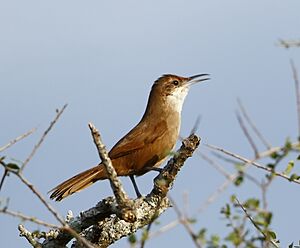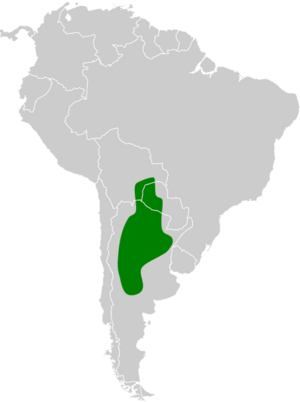Chaco earthcreeper facts for kids
Quick facts for kids Chaco earthcreeper |
|
|---|---|
 |
|
| at Capivara, Santa Fe, Argentina | |
| Conservation status | |
| Scientific classification | |
| Genus: |
Tarphonomus
|
| Species: |
certhioides
|
 |
|
| Synonyms | |
|
Ochetorhynchus certhioides |
|
The Chaco earthcreeper (Tarphonomus certhioides) is a type of bird that belongs to the ovenbird family called Furnariidae. You can find it in Argentina, Bolivia, and Paraguay. Sometimes, it even shows up in Brazil, but that's rare.
Contents
About This Bird
What's in a Name?
The Chaco earthcreeper has had a few different scientific names over the years. Scientists first placed it in groups like Ochetorhynchus and Upucerthia. But since the early 2000s, it has been part of the Tarphonomus group.
This bird is very closely related to another bird called the Bolivian earthcreeper (T. harterti). They are like "sister species," meaning they share a very close ancestor. These two are also related to the rusty-winged barbtail and the birds in the Pseudocolaptes group.
There are three slightly different kinds, or subspecies, of the Chaco earthcreeper:
- T. c. certhoides
- T. c. luscinia
- T. c. estebani
What Does It Look Like?
The Chaco earthcreeper is about 16 cm (6.3 in) long. It weighs between 18 to 31 g (0.63 to 1.1 oz). It's a small bird with a bill that's a bit long and curves slightly downwards. Both male and female birds look the same.
Colors and Markings
Adult birds of the main subspecies (T. c. certhoides) have a faint orange-red stripe above their eyes. Their face is mostly dark brown. The top of their head and back are dull dark brown. Their lower back and upper tail feathers are a reddish-brown. Their tail is generally dull brown, with the outer feathers being more reddish. Their wings are a bit more reddish-brown than their back.
Their throat and cheeks are white. Their chest and belly are brown, and their sides and under-tail feathers are reddish. Their eyes are brown. The upper part of their beak is dark gray, and the lower part is slate gray or pinkish-gray. Their legs and feet are dark gray.
Young Chaco earthcreepers have a reddish tint all over, but their forehead is less reddish than adult birds.
Subspecies Differences
- The T. c. luscinia subspecies has grayer upper parts and more reddish wings. Its underparts are also paler than the main subspecies.
- The T. c. estebani subspecies has a paler back and a duller chest and belly. It doesn't have the reddish tint on its sides like the main subspecies.
Where Does It Live?
The Chaco earthcreeper lives in different parts of South America:
- The T. c. estebani subspecies is found in south-central Bolivia, northern Argentina, and western Paraguay.
- The T. c. luscinia subspecies lives in western Argentina, in provinces like San Juan, La Rioja, Córdoba, Mendoza, and San Luis.
- The main subspecies, T. c. certhoides, is found in northeastern Argentina, from Río Negro Province north to Formosa Province. It has also been seen once in Brazil.
Its Home Environment
The T. c. estebani and T. c. certhoides subspecies like to live in thick scrublands and forests where trees lose their leaves (deciduous woodland). They especially like areas with bromeliad plants growing on the ground. The T. c. luscinia subspecies prefers slopes with thick bushes in the foothills of the Andes mountains. This bird can be found at elevations up to 1,800 meters (about 5,900 feet) high.
Bird Behavior
Staying Put
The Chaco earthcreeper stays in the same area all year round. It doesn't migrate to different places.
What It Eats
This bird mainly eats arthropods, which are creatures like insects and spiders. It usually looks for food by itself. It picks up its prey from the ground and sometimes from low plants.
Building a Home and Raising Young
The Chaco earthcreeper breeds during the Southern Hemisphere's summer. It is believed that a male and female bird stay together for breeding.
They build their nests using sticks. They might build a nest in a bush or a tree. They also use holes in trees, rock faces, or old buildings. Sometimes, they even use old nests built by another bird called a Furnarius hornero. They make the inside of the nest soft with materials like hair, grass, and other plant fibers.
A female bird usually lays three or four eggs. Scientists don't know exactly how long the eggs take to hatch or when the young birds leave the nest. They also don't know many details about how the parents care for their babies.
What Does It Sound Like?
The Chaco earthcreeper's song is a series of 5 to 15 loud, squeaky "chiqui" notes. These notes get louder and then go down in pitch. Its call is a loud whistle that sounds like "tééoo" or "tuéét."
Its Conservation Status
The International Union for Conservation of Nature (IUCN) has looked at the Chaco earthcreeper and decided it is a species of "Least Concern." This means it's not currently in danger of disappearing. It lives across a large area, and even though we don't know the exact number of birds, its population seems to be stable. There are no immediate threats that scientists have found. It's quite common in most places where it lives and can be found in at least one protected nature area.


